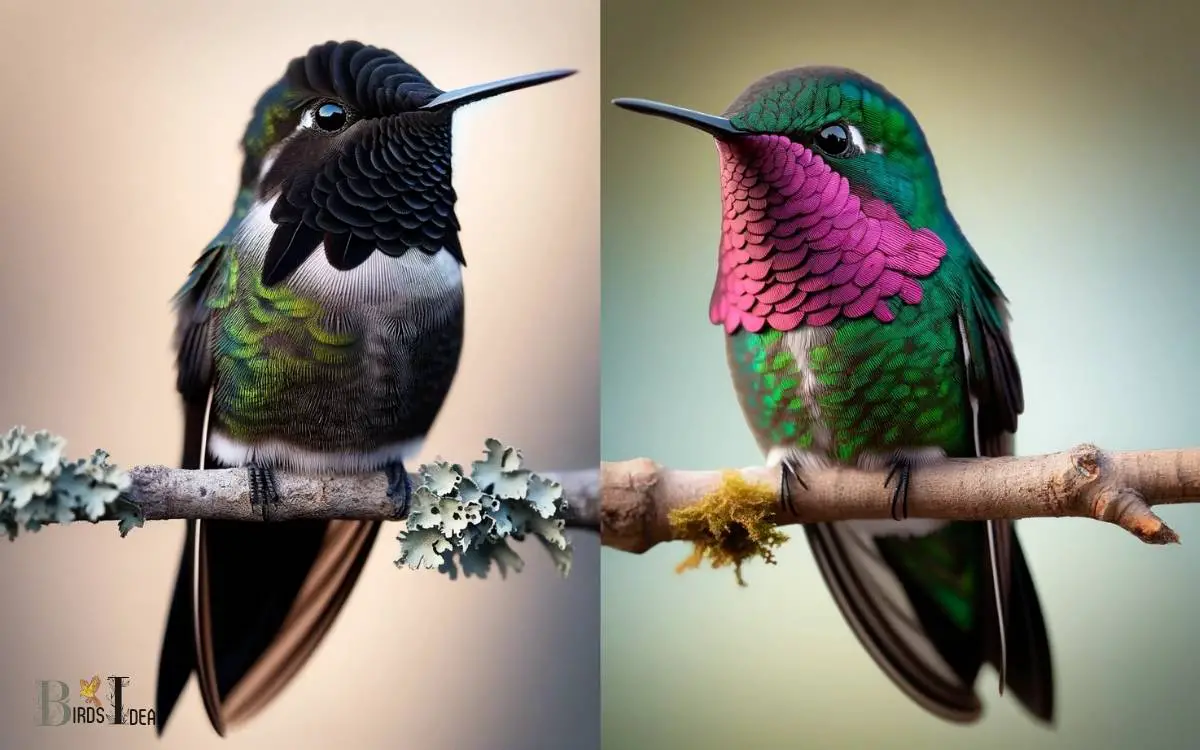Black Chinned Vs Broad Tailed Hummingbird: Comparison!
The Black-chinned Hummingbird (Archilochus alexandri) and the Broad-tailed Hummingbird (Selasphorus platycercus) are both common in the western United States but have distinct characteristics that set them apart.
The Black-chinned Hummingbird is identified by its black, shimmering throat with a purple edge and green back, while the Broad-tailed Hummingbird is notable for its rose-red throat and distinctive broad tail with rufous coloring.
Black-chinned and Broad-tailed Hummingbirds often share similar habitats but have different behaviors and physical traits.
Black-chinned Hummingbird:
Broad-tailed Hummingbird:
Understanding these differences is crucial for birdwatchers and ornithologists when identifying and studying hummingbird species in their natural habitats.
While both species are a marvel of nature, the Black-chinned Hummingbird’s subtle purple iridescence and the Broad-tailed Hummingbird’s distinctive tail.

Key Takeaway
Physical Characteristics
Both the Black Chinned and Broad Tailed Hummingbirds exhibit distinct physical characteristics that facilitate their unique flight patterns and foraging behaviors.
The Black Chinned Hummingbird is distinguished by its iridescent green back and crown, a black chin patch, and a white breast. Its wings produce a distinctive whirring sound during flight.
Conversely, the Broad Tailed Hummingbird is characterized by its iridescent emerald green back, a rosy-red throat patch on males, and a white breast. Its wings produce a distinctive trilling sound during flight.
These physical attributes are essential for their aerobatic flight maneuvers and hovering capabilities. The differences in their plumage and wing sounds contribute to their successful foraging strategies and play a vital role in their ecological niche.
Plumage and Coloration
Hummingbirds are known for their vibrant plumage, with variations across different species. Their colorful feathers play a crucial role in mating displays and courtship rituals.
Examining the differences in plumage and coloration is essential for accurately identifying and distinguishing between Black Chinned and Broad Tailed Hummingbirds.
Plumage Variations in Species
The plumage variations in the Black Chinned and Broad Tailed Hummingbirds exhibit distinctive coloration and patterns, contributing to their unique visual characteristics.
The differences in their plumage are essential for birdwatchers and researchers to identify and distinguish between the two species.
Here are some key plumage variations to look out for:
- Throat Color: The Black Chinned Hummingbird features a vibrant purple throat patch, while the Broad Tailed Hummingbird displays a brilliant rose-red throat.
- Tail Feather Patterns: The Black Chinned Hummingbird has a deeply notched tail with white tips on the outer feathers, whereas the Broad Tailed Hummingbird’s tail is more rounded and lacks the white tips.
- Head Markings: The Black Chinned Hummingbird has a dark line behind its eye, while the Broad Tailed Hummingbird possesses a distinctive white line over and behind the eye.
- Overall Plumage: The Black Chinned Hummingbird exhibits a predominantly greenish upper plumage, whereas the Broad Tailed Hummingbird displays a more bronzy-green upper plumage.
Coloration for Mating Display
During mating displays, Black Chinned and Broad Tailed Hummingbirds exhibit distinct coloration patterns to attract potential mates.
The Black Chinned Hummingbird (Archilochus alexandri) features a predominantly iridescent green plumage with a black, shimmering throat patch, while the male Broad Tailed Hummingbird (Selasphorus platycercus) showcases iridescent green feathers with a rosy-red throat patch, bordered by iridescent pinkish-purple gorget feathers.
These coloration patterns are crucial for attracting mates during courtship displays, as the vibrant and iridescent colors signal genetic fitness and overall health.
The following table highlights the key coloration differences between the two species:
| Hummingbird Species | Plumage Color | Throat Patch Color |
|---|---|---|
| Black Chinned | Iridescent green, black throat patch | Black |
| Broad Tailed | Iridescent green, rosy-red throat patch, pinkish-purple gorget feathers | Rosy-red, pinkish-purple |
Identifying Plumage Differences
To distinguish between the Black Chinned and Broad Tailed Hummingbirds, careful examination of their plumage and coloration is essential for accurate identification.
Here are some key plumage differences to look for:
- Throat Color: The Black Chinned Hummingbird has a black or dark purple throat, while the Broad Tailed Hummingbird has a bright rose-red throat patch.
- Tail Feathers: The Black Chinned Hummingbird typically has a slightly notched and darker tail, whereas the Broad Tailed Hummingbird’s tail is broader and more square in shape with a striking iridescent green coloration.
- Crown Color: The Black Chinned Hummingbird features a dark, iridescent purple crown, whereas the Broad Tailed Hummingbird displays a vibrant metallic green crown.
- Underparts: The underparts of the Black Chinned Hummingbird are a pale grayish color, while the Broad Tailed Hummingbird has a white or pale gray underbelly with a greenish wash on the sides.
Behavioral Traits
When comparing the Black Chinned and Broad Tailed Hummingbirds, their behavioral traits play a significant role in distinguishing between the two species.
This includes their feeding preferences and foraging techniques, courtship and mating rituals, as well as their territorial behavior and aggression.
Understanding these behavioral traits provides valuable insights into the distinct characteristics and interactions of these fascinating hummingbird species.
Feeding Preferences and Foraging
Feeding on nectar from a variety of flowers, both the Black Chinned and Broad Tailed Hummingbirds exhibit distinct foraging behaviors reflecting their specialized feeding preferences.
- Flower Selection: The Black Chinned Hummingbird tends to favor tubular flowers, while the Broad Tailed Hummingbird shows a preference for more open, cup-shaped blooms.
- Foraging Heights: Black Chinned Hummingbirds are often found foraging at lower levels, while the Broad Tailed Hummingbird is commonly seen feeding at higher elevations.
- Territoriality: Black Chinned Hummingbirds are known to aggressively defend feeding territories, whereas the Broad Tailed Hummingbird tends to be more tolerant of sharing feeding sites.
- Migration Patterns: The Black Chinned Hummingbird typically migrates earlier in the spring and later in the fall compared to the Broad Tailed Hummingbird, potentially influencing their foraging opportunities.
Courtship and Mating Rituals
During courtship and mating rituals, behavioral traits of the Black Chinned and Broad Tailed Hummingbirds reveal distinct characteristics that distinguish their mating behaviors.
The Black Chinned Hummingbird engages in elaborate courtship displays, often involving impressive aerial acrobatics to attract a mate. Males perform a series of dives and swoops while creating a distinct buzzing sound with their tail feathers.
In contrast, the Broad Tailed Hummingbird’s courtship display is marked by a high-speed, U-shaped flight pattern, emitting a distinctive high-pitched trill.
Both species exhibit territorial behaviors during courtship, with males vigorously defending their chosen breeding grounds from other males.
Once a mate is chosen, the male and female engage in a brief ritualized dance before copulation. These differing courtship and mating behaviors highlight the unique strategies employed by each species to ensure successful reproduction.
Territorial Behavior and Aggression
The territorial behavior and aggression displayed by both the Black Chinned and Broad Tailed Hummingbirds are essential components of their mating strategies, ensuring the protection of their chosen breeding grounds and successful reproduction.
- Territorial Defense: Both species vigorously defend their territory, often engaging in aerial chases and physical confrontations with intruding hummingbirds.
- Vocal Displays: They use vocalizations to assert dominance and demarcate their territory, warning off potential rivals and attracting mates.
- Aggressive Displays: During the breeding season, male hummingbirds showcase aggressive behaviors such as dive-bombing and tail fanning to intimidate competitors and assert their dominance.
- Mate Protection: Aggressive behavior extends to protecting mates and nesting sites, with both species fiercely guarding their partners and offspring from potential threats.
Feeding Habits
While foraging for nectar, both the Black Chinned and Broad Tailed hummingbirds display distinct feeding habits. The Black Chinned hummingbird is known for its preference for tubular flowers, often favoring red or orange blooms.
It has a tendency to feed at lower levels, making it more likely to visit feeders and low-hanging flowers. In contrast, the Broad Tailed hummingbird is attracted to a wider variety of flowers and is especially drawn to those with a more diluted nectar.
Its feeding habits often lead it to higher elevations compared to the Black Chinned hummingbird. Additionally, the Broad Tailed hummingbird is known for its unique ability to hover in front of flowers while feeding, showcasing its impressive aerial agility.
These differing feeding habits contribute to the ecological roles and behaviors of these two hummingbird species.
Nesting and Reproduction
Nesting and reproducing are pivotal aspects of the life cycle for both the Black Chinned and Broad Tailed hummingbirds. These tiny birds exhibit intriguing behaviors when it comes to creating a suitable environment for their offspring.
Here are some key points to consider:
- Nest Construction: Black Chinned hummingbirds often construct their nests using plant fibers, spider silk, and downy materials, while Broad Tailed hummingbirds prefer mosses, lichens, and spider webs, creating delicate and camouflaged structures.
- Clutch Size: The Black Chinned hummingbird typically lays 2 eggs, whereas the Broad Tailed hummingbird lays 3-4 eggs, with an incubation period of about 15-16 days for both species.
- Feeding Young: Both species feed their young a diet high in protein, consisting of small insects and nectar, to ensure proper growth and development.
- Mating Behavior: Male hummingbirds of both species perform elaborate aerial displays to attract females during the mating season.
Understanding these nesting and reproductive behaviors provides valuable insight into the fascinating world of these vibrant hummingbirds.
Migration Patterns
During migration, Black Chinned and Broad Tailed hummingbirds travel long distances, following specific routes and stopping at various locations to refuel and rest before reaching their final destinations.
Both species exhibit remarkable migratory feats, with the Black Chinned hummingbirds traveling from as far north as Canada to their wintering grounds in Mexico and Central America.
On the other hand, Broad Tailed hummingbirds embark on an equally impressive journey from their breeding grounds in the western United States to their wintering areas in Mexico.
Their migratory patterns are influenced by factors such as food availability, weather conditions, and breeding instincts.
Understanding these migration patterns is crucial for conservation efforts, as it helps in identifying critical stopover sites and protecting their habitats along their migration routes.
Vocalizations and Sounds
Vocalizations and sounds play a significant role in the communication and social interactions of both Black Chinned and Broad Tailed hummingbirds, offering insights into their behavior and territoriality during migration and at stopover sites.
- Songs: Male Black Chinned hummingbirds produce a series of high-pitched, scratchy calls, while male Broad Tailed hummingbirds emit a distinctive metallic trill during courtship displays.
- Aggression Calls: Both species use sharp, chattering sounds to defend their territories and repel intruders, particularly during the breeding season.
- Feeding Chatter: Black Chinned hummingbirds often emit rapid, chattering calls while foraging, whereas Broad Tailed hummingbirds are known for their soft, squeaky calls during feeding.
- Communication with Offspring: Female Black Chinned hummingbirds use soft peeping sounds to communicate with their young, while female Broad Tailed hummingbirds produce a series of low chipping notes to do the same.
Preferred Habitats
Both the Black Chinned and Broad Tailed hummingbirds are commonly found in diverse habitats throughout their ranges, exhibiting distinct preferences for specific environmental conditions.
The Black Chinned hummingbird tends to favor arid and semi-arid habitats, including deserts, scrublands, and canyons, often at elevations up to 6,000 feet.
In contrast, the Broad Tailed hummingbird is typically found in montane and subalpine coniferous forests, preferring areas with dense vegetation, particularly near streams or wetlands.
These habitats provide ample sources of nectar from flowering plants, which form the primary food source for these birds.
Understanding these habitat preferences is crucial for creating suitable environments to attract and support these hummingbird species, whether through backyard gardens or conservation efforts in natural areas.
Conservation Status
The conservation status of the Black Chinned and Broad Tailed hummingbirds indicates their respective population trends and the level of threat they face in their natural habitats.
- Population Trends: The Black Chinned hummingbird is categorized as a species of Least Concern, with a stable population trend. In contrast, the Broad Tailed hummingbird is also classified as a species of Least Concern, but with a decreasing population trend due to habitat loss and climate change.
- Habitat Loss: Both species face threats from habitat loss, primarily due to human activities such as urbanization, agriculture, and deforestation.
- Climate Change: The impact of climate change on these hummingbird species is a growing concern, affecting the availability of nectar-bearing flowers and altering their migratory patterns.
- Conservation Efforts: Conservation efforts are underway to protect and restore their natural habitats, including the establishment of protected areas and the promotion of sustainable land use practices.
Conclusion
The black-chinned and broad-tailed hummingbirds exhibit similar physical characteristics, plumage, and behaviors, making it challenging to distinguish between the two.
Despite their differences in feeding habits and nesting preferences, both species face similar conservation threats.
Ironically, while these hummingbirds may appear distinct to the casual observer, their shared challenges highlight the need for unified conservation efforts to ensure the continued survival of these remarkable birds.






